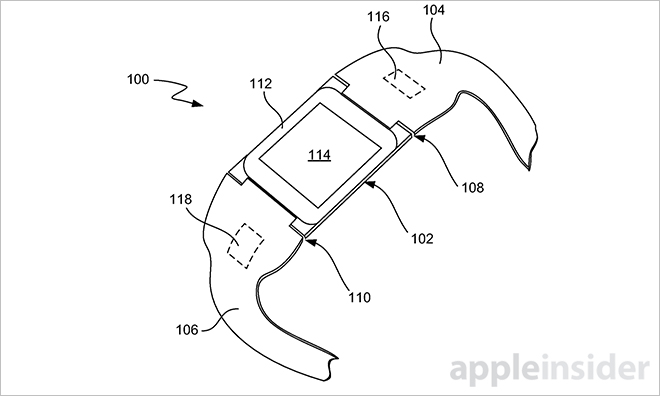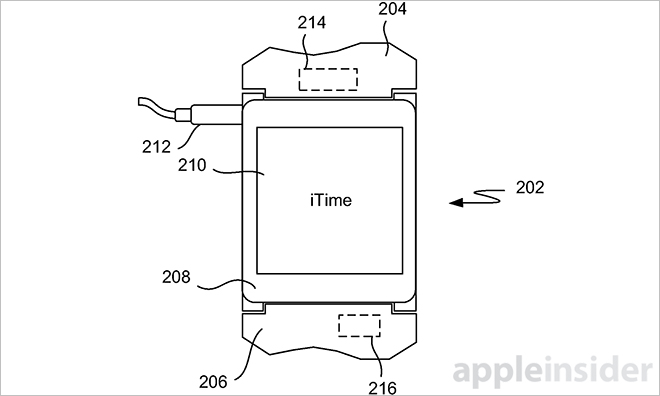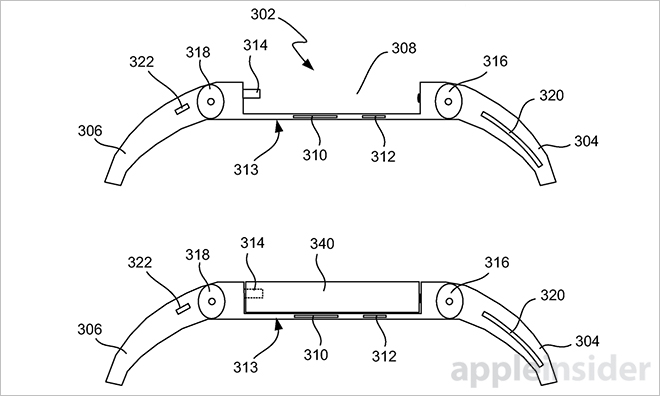Apple granted comprehensive 'iTime' smartwatch patent with in-strap circuitry, arm gesture support
In one of the clearest signs that Apple is — and has been — working on a smartwatch device, the Cupertino company was on Tuesday granted a patent for a wrist-worn wearable with augmented strap capabilities, support for arm and wrist gestures, advanced proximity-sensing circuitry and much more.
As published by the U.S. Patent and Trademark Office, Apple's U.S. Patent No. 8,787,006 for a "Wrist-worn electronic device and methods therefor" describes a device (dubbed "iTime" in one illustration) that fits squarely with speculation regarding a so-called "iWatch" smartwatch.
The invention's main claims, as the title implies, revolve around a wrist-worn device that can connect with other portables like iPhones and iPads, computers, or even the watch's straps, which integrate sensors and other circuitry to augment device performance.
Basically, a majority of the property details what can be considered a "smart wristband" that features a receptacle for a portable media player. What comes later in the patent, however, potentially reveals Apple's smartwatch aspirations.
As noted, much of the invention pertains to a convertible style smartwatch that incorporates a central electronic device removably secured to an advanced strap strap system. The idea harkens back to the days of Apple's sixth-generation iPod nano, which spawned a cottage industry for ad-hoc solutions that turned the media player into a wristwatch-style device. In fact, Apple's patent background alludes to the iPod nano by name.
Operationally, the system is based on the idea of converting the square-shaped iPod nano into a smartwatch. Initial claims note the media player can be inserted into specially-made straps that integrate various electrical components to augment the device's capabilities. The document mentions parts like accelerometers, GPS modules, wireless communication packages and haptic feedback mechanisms as potential candidates for inclusion in the advanced strap structure.
Things start to get interesting when Apple describes what it calls a "personal wireless environment." In essence, the invention illustrates an ecosystem in which the electronic wristwatch can interact with nearby devices like an iPhone, laptop or desktop computer.
Apple goes on to detail how this "piconet" works. Through either wired or wireless communication protocols, the wristwatch can operatively connect to a cellular or Internet-connected device. In this way, information can be exchanged from iPhone to watch, or watch to iPhone, either automatically or at a user's request.
In one embodiment, the watch is able to receive a notification initiated by a nearby phone, then alert the user to the event through audio, visual or haptic feedback (vibrations). Once alerted, the user has the option to take out their iPhone or dive into the notification directly on the watch, whether it be onscreen or through audio output like system speakers or headphones.
Various embodiments allow for incoming phone calls, text messages, social and news network feeds, among other information, to be displayed on the wristband's display. Apps can tap into the functionality and provide their own notifications, assumedly through iOS APIs. Data is "pushed" to the wearable dynamically, but more importantly users are able to handle the information directly by interacting with the source device.
For example, the wristwatch provides controls for a media player, while other options include control over apps or system-level functions.
Apple is describing a wristband-based remote input/output interface with high-level controls for a mobile phone, otherwise known as a smartwatch.
The patent goes further, noting the wristband can also be linked to an iPhone in order to alert the user when it is left behind, stolen or out of range. While not mentioned in the IP, an appropriate communications protocol for such functionality would be Bluetooth 4.0, which supports proximity-based operations.
The remainder of Apple's patent looks at physical embodiments of the invention, many of which deal with connecting and securing a portable media player like the aforementioned iPod nano.
There is, however, a key embodiment that does not require any additional devices. As illustrated in the image above, all components can be incorporated into a single enclosure, complete with display, sensors, circuitry and I/O controls.
Specifically, electronics available for integration in either the smartwatch core unit or surrounding strap structure include haptic mechanisms, various sensors, biometric components, GPS modules, NFC antennas, Bluetooth packages, proximity detectors and more.
Finally, tacked on to the end of the document is a contingency for arm and wrist gestures. Instead of controlling the smartwatch via fingers, users would be able to shake, bounce, tap or otherwise interact with the device through physical movements. Gesture combinations can be assigned to certain device controls. For example, an incoming call may be answered by a single wrist shake, or declined with two shakes and a tap.
Apple is widely expected to introduce an "iWatch" device with functionality very similar to that described in the patent above. Previously the stuff of rumors, evidence that the connected device exists is quickly mounting. According to the most recent speculation, Apple's first foray into the wearables game may sport a "slightly curved" 2.5-inch OLED display and could come in three sizes. The device is also said to have a heavy focus on health and wellness, with possible fitness tracking functions built-in.
While a specific launch date — and the product itself — has yet to be revealed, noted KGI Securities analyst Ming-Chi Kuo forecasts iWatch production to begin in November ahead of a December or early 2015 rollout.
Apple's comprehensive "iTime" smartwatch patent was first filed for in 2011 and credits Albert J. Golko, Mathias W. Schmidt and Felix Alvarez as its inventors.
 Mikey Campbell
Mikey Campbell














 Malcolm Owen
Malcolm Owen
 William Gallagher and Mike Wuerthele
William Gallagher and Mike Wuerthele
 Christine McKee
Christine McKee
 William Gallagher
William Gallagher

 Marko Zivkovic
Marko Zivkovic









